February 2018 was, thankfully, on the whole, much better for wildlife - watching than the previous month weather-wise, with the several brief snowy cold snaps interspersed with a few milder spells...and with the days lengthening, snowdrops and crocuses blooming, woodpeckers drumming, songbirds singing, and temperatures approaching double figures on a few occasions, it even , dare I say it?....felt a little spring-like at times...though not at the very end of the month when the Arctic storm dubbed the 'Beast from the East' reminded us in no uncertain terms that it was still very much winter!!!....
Full-day local safari bird lists increased a little this month, with the first returning waders pushing the totals up into the high 40's, though a trip to the nearby Moray Coast or Black Isle can increase this number considerably, whilst mammal day lists varied between 5 and 9 species depending on the time of our start and number of habitats visited, with early starts usually proving more successful for the shyer creatures.
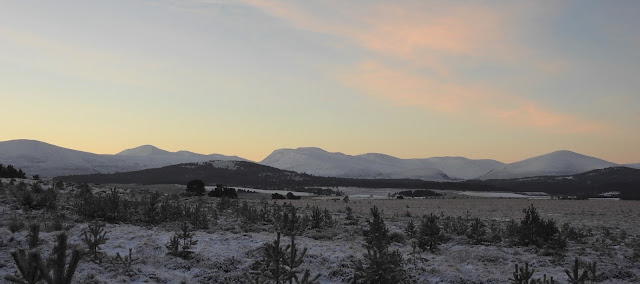 |
| A frosty dawn on a local upland moor |
To give you an idea of what you may realistically hope to see if you are planning a future February visit yourself, I hope the following more detailed information, illustrated with photos taken by myself, my friends or my safari clients in this area will help - clicking on the picture enlarges it to full screen.
Wildlife highlights included:
Local speciality/upland bird species seen regularly during the month included:
Black Grouse (at dawn only),
Red Grouse,
Crested Tit,
Dipper , Golden Eagle, and we also had a few decent sightings of
Snow Bunting, though
Capercaillie and
Crossbills again proved elusive....
Winter visiting birds were represented by a few remaining family groups of
Whooper Swans, a few flocks of several species of 'grey'
Geese, lots of wildfowl such as
Goldeneye, Tufted Duck, Wigeon and Teal, whilst
a handful of annoyingly mobile
Waxwings continued to pillage our fast disappearing berries throughout the month...a few
Bramblings,
Redpolls,
Redwings and
Fieldfares were also seen......
Local breeding birds , in the form of waders such as
Lapwing,
Oystercatcher and
Curlew began to appear inland for the first time since the autumn...with numbers increasing throughout the month....
Mammals seen regularly locally during the month included:
Red Deer,
Roe Deer,
Reindeer,
Sika Deer,
Red Squirrel,
Rabbit,
Mountain Goat,
Brown Hare, and
Mountain Hare (white), with just a few brief glimpses of
Bank Vole...Whilst a couple of trips to the Moray coast gave good views of both
Common and
Grey Seal...
 |
| Dawn at a Black Grouse lek |
Dawn (still a pretty user-friendly 7 am) on my safaris was usually spent at a local
Black Grouse lek site, where we braved the usually freezing temperatures and often wintry weather to enjoy the spectacle of up to 6 of these attractive, and increasingly rare, blue-black cock birds displaying, posturing aggressively and flutter-jumping in a bid to out-display and intimidate their opponents in a bid to secure their little patch of the moorland 'arena' for the forthcoming breeding season, all accompanied by their strange bubbling and whooshing calls drifting across the moor... surely one of British wildlife's 'must-see' (and 'must hear') experiences? 'Performances' were noticeably better on cold, still mornings.... but please be aware that the birds can fail to show in wet and windy weather....
 |
| Cock Red Grouse |
In the heather too, pre-breeding season behaviour seems to be escalating, though in a very different style to their black cousins, with the cock
Red Grouse, red eyebrows bulging, staking out a 'territory' and defending it from intruders whilst uttering their guttural, cackling calls .. often accompanied by a doting hen bird.....
 |
| Crested Tit by Bob Smith |
My favourite forest feeding stations again proved to be very successful in luring
Crested Tits for us to see and photograph at close range, with the colder days proving to be best and the milder days less so, but with the 'Wee Cresties' and many of the other forest birds also showing early signs of breeding season behaviour, I suspect that the days of 'easy' sightings may be coming to an end as their reliance on non-natural food decreases, and the urge to breed kicks in....
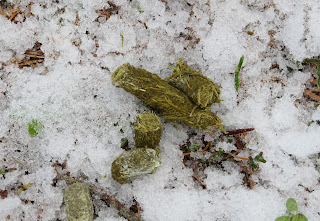 |
| Capercaillie poo |
Sadly,
Capercaillie were not seen at all again, despite several dawn walks in suitable habitat, with the only evidence of their presence being a few of their 'cigarettes' of pine needle filled poo seen on quiet forest tracks.....
Still in the Caledonian pine forests, rather frustratingly,
Crossbills too were again very much a 'bogey-bird', with sightings restricted to snatched glimpses of calling birds flying around the tree tops...even though we spent almost a full day walking round local forest sites on the 24th in search of them... are they feeding and breeding elsewhere? or maybe it is just me?!!
 |
| Dipper |
Dippers featured frequently on my safaris this month, with visits to my favourite local sites often giving us good views of these upland river specialities, sometimes carrying nest material close to likely nest sites, usually near a bridge, and occasionally singing and displaying to a prospective mate......and with these hardy little birds absent from much of the UK, many of my safari clients were seeing them for the first time.....
 |
| Snow Bunting |
Although I had one (unsuccessful) trip high up into the peaks in search of the mountain-top species such as
Ptarmigan this month, thankfully the snowy cold spells tempted the
Snow Buntings down to slightly lower levels, giving us the chance of great close-up views and photo opportunities of up to 30 of these delightful little birds...
 |
| Golden Eagle by Steve Nicklin |
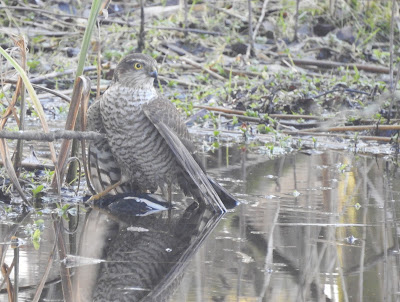 |
| Female Sparrowhawk clutching freshly caught and drowned Woodpecker! |
Golden Eagle is a rare, iconic, localised and much sought-after bird in the UK, and as I have mentioned before, the shorter days of the winter months give us our best chance of seeing them. This month continued the trend, and we were lucky enough to enjoy a number of memorable sightings of these majestic birds hunting in upland glens, including the rare treat of one seen chasing a fully-grown Red Deer hind along a ridge on the 22nd!!
Raptors in general were pretty well represented this month, with
Kestrel,
Sparrowhawk,
Common Buzzard, Peregrine, Goshawk and
Red Kite all being seen at least once...
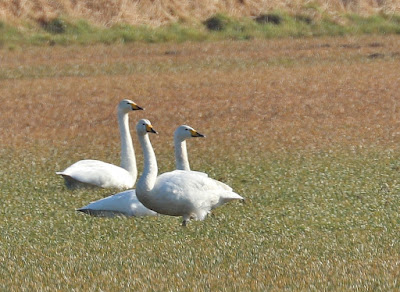 |
| Whooper Swans |
Whooper Swans could still be seen on local lochs, though in smaller numbers now, but they were again quite mobile and elusive, seemingly transferring to the rivers and flooded fields when the lochs froze over....
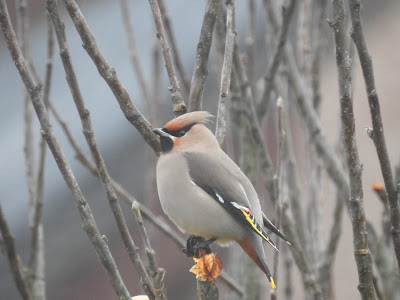 |
| Waxwing |
Waxwings were reported locally up to mid-month, mostly in just ones and twos, with the flock of 8 birds at Aldi car park in Inverness again proving to be the most reliable .....though they were not reported there after the 10th.
 |
| Eiders by Bob Smith |
The Moray coast is only about 40 miles North East of Aviemore, and several trips to favourite reserves, salt marshes, lochs, bays and harbours gave good views of
Eiders,
Greylag Geese,
Pink-Footed Geese,
Whooper Swan,
Wigeon,
Teal,
Pintail,
Bar-Tailed Godwit,
Knot, Golden Plover ,
Grey Plover , Ringed Plover , Guillemot, Black Guillemot, and
Long-Tailed Duck and we also managed to see the
American Wigeon...
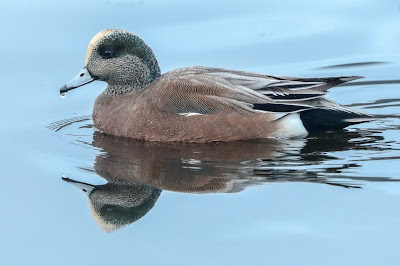 |
| American Wigeon by Ron Mitchell |
 |
| Long-Tailed Ducks by Bob Smith |
Other good birds reported locally this month included: Green-Winged Teal, Spotted Redshank, Kingfisher, Iceland Gull and Glaucous Gull....
Onto mammals now.....
 |
| Mountain Hare by Bob Smith |
Our local
Mountain Hares once again 'stole the show' this month, and it is very hard to argue against them being voted as 'mammal of the day' when you take into account their gorgeous looks in their winter white coats, their relative scarcity in the UK, and the often spectacular upland habitat in which they are found.
 |
| Red Squirrel |
Red Squirrels too proved to be very popular with my safari clients, again scoring highly for cuteness, and rarity, and we were fortunate enough to enjoy watching up to 3 of these characterful and entertaining little animals enjoying an easy peanut meal at my favourite forest feeding stations...
 |
| Feral Mountain Goats |
Up in the glens,
Feral Mountain Goat sightings were a little more frequent this month, though they were mostly of the larger horned males, and still no sign of any youngsters yet....
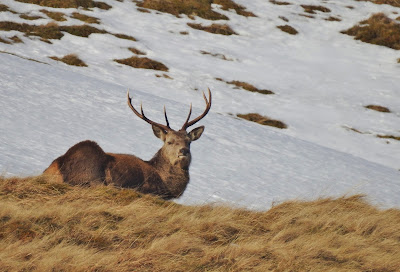 |
| Red Deer stag |
Red Deer could often be seen well in their large same-sex herds, but only if you used a bit of fieldcraft, and concentrated on looking for them on the leeward side of the hills, as although they are pretty hardy, they are clearly not daft......
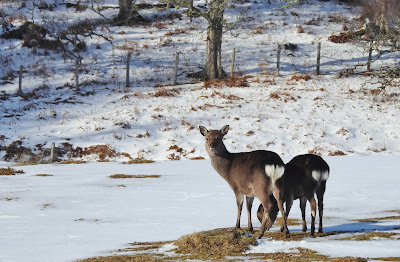 |
| Sika Deer |
Sika Deer were encountered surprisingly frequently on my safaris this month, with many of my clients seeing them for the first time. For those not familiar with this species, they originate from Asia and were introduced into the UK in the late 19th century...
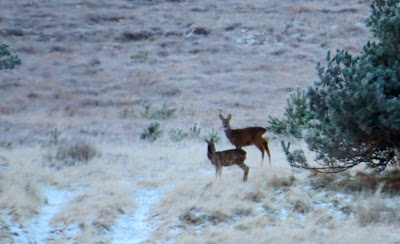 |
| Roe Deer |
Roe Deer however, can be a little trickier to see, being more wary of human disturbance, and most of our sightings were at dawn or in very remote areas, and were usually of the 'brief' variety, as they ran away on becoming aware of us...
So to sum up, despite the often inclement weather, we appear to have continued our decent start to the safari year, with plenty of local specialities and winter visitors seen, the first 'summer' visitors arriving, and even a few unexpected bonuses seen.....and with winter finally coming towards it's end (I hope!), and spring on the horizon...we are fast approaching my favourite time of the wildlife-watching year.....
If you think you know someone who may enjoy a taste of what I do, why not treat them to a safari gift certificate. They make a thoughtful and imaginative present and are available for any amount and are valid at any time within a year from date of purchase....
 |
| Lossiemouth East Beach |








